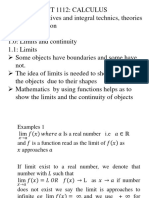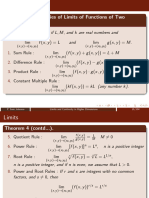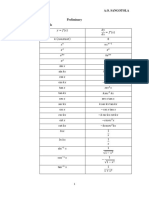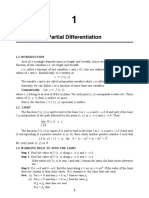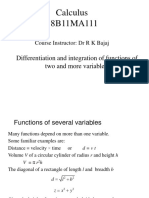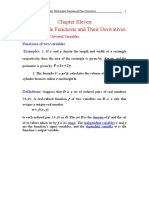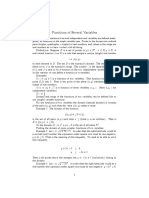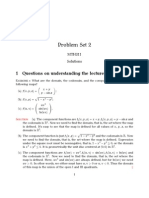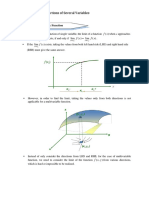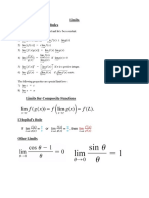Partial Derivatives - Lecture Notes
Uploaded by
devrsahani23Partial Derivatives - Lecture Notes
Uploaded by
devrsahani23Gandhinagar Institute of Technology
Lecture Notes
Of
Partial Derivatives and Its Applications
Program (UG): B. TECH
Name of Department: Mathematics and
Humanities
Academic Year: 2023-2024
Semester: 1st
Subject Code: 10000101
Subject Name: Engineering Mathematics I
Name of the Institute: Gandhinagar Institute of
Technology
Mathematics and Humanities Department 10000101 EM I
Gandhinagar Institute of Technology
PARTIAL DERIVATIVES
Limit:
The function 𝑓(𝑥, 𝑦) is called a real-valued function of two or more variables if
there are two or more independent variables.
e.g., The area of a rectangle with sides of lengths 𝑥 and 𝑦 is given by 𝐴 = 𝑥𝑦. Here, 𝐴
(area) depends on 𝑥 and 𝑦. So, 𝐴 is dependent variable and 𝑥 and 𝑦 are independent
variable.
Definition:
If 𝑓(𝑥, 𝑦) is a function of two variables, 𝑥, 𝑦 then lim 𝑓(𝑥, 𝑦) = 𝑙. In general,
(𝑥,𝑦)→(𝑎,𝑏)
for any chosen number 𝜖 > 0 however small, there exists a number 𝛿 > 0 such that
|𝑓(𝑥, 𝑦) − 𝑙| < 𝜖 for all values of (𝑥, 𝑦) for which |𝑥 − 𝑦| < 𝛿 and |𝑦 − 𝑏| < 𝛿
Working Rules to find the limit
Let lim 𝑓(𝑥, 𝑦) be a limit function. Consider the following cases:
(𝑥,𝑦)→(𝑎,𝑏)
Case 1: If 𝑎 ≠ 0, 𝑏 ≠ 0 i.e. (𝑎, 𝑏) ≠ (0,0) then
Step 1: Find the value of 𝑓(𝑥, 𝑦) along 𝑦 → 𝑏 and 𝑥 → 𝑎
Step 2: Find the value of 𝑓(𝑥, 𝑦) along 𝑥 → 𝑎 and 𝑦 → 𝑏
• If the values of 𝑓(𝑥, 𝑦) in Step 1 and Step 2 are same, then the limit exists and
that value is the limit of 𝑓(𝑥, 𝑦) otherwise limit does not exist.
Case 2: If 𝑎 = 0 and 𝑏 = 0 i.e. (𝑎, 𝑏) = (0,0) then
Step 1: Find the value of 𝑓(𝑥, 𝑦) along 𝑦 → 0 and then 𝑥 → 0
i.e. lim lim 𝑓(𝑥, 𝑦) = 𝑓1 (Say)
𝑦→0 𝑥→0
Step 2: Find the value of 𝑓(𝑥, 𝑦) along 𝑥 → 0 and then 𝑦 → 0
i.e. lim lim 𝑓(𝑥, 𝑦) = 𝑓2 (Say)
𝑥→0 𝑦→0
• If 𝑓1 = 𝑓2 then Go to step 3.
Step 3: Find the value of 𝑓(𝑥, 𝑦) along 𝑦 → 𝑚𝑥 and then 𝑥 → 0
i.e. lim lim 𝑓(𝑥, 𝑦) = 𝑓3 (Say)
𝑥→0 𝑦→𝑚𝑥
• If 𝑓1 = 𝑓2 ≠ 𝑓3 then limit of a function does not exist.
• If 𝑓3 is a function of 𝑚 only then limit of a function does not exist.
• If 𝑓1 = 𝑓2 = 𝑓3 then go to step 4.
Mathematics and Humanities Department 10000101 EM I
Gandhinagar Institute of Technology
Step 4: Find the value of 𝑓(𝑥, 𝑦) along 𝑦 → 𝑚𝑥 𝑛 and then 𝑥 → 0
i.e. lim lim 𝑛 𝑓(𝑥, 𝑦) = 𝑓4 (Say)
𝑥→0 𝑦→𝑚𝑥
• If 𝑓1 = 𝑓2 = 𝑓3 ≠ 𝑓4 then limit of a function does not exist. If 𝑓4 is a function of
𝑚 only then limit does not exist. If 𝑓1 = 𝑓2 = 𝑓3 = 𝑓4 = 𝑙 (say) then limit of a
function exists.
Thus,
lim 𝑓(𝑥, 𝑦) = 𝑙
(𝑥,𝑦)→(0,0)
𝑥𝑦
Example 1.1: Evaluate lim
(𝑥,𝑦)→(0,0) 𝑥 2 +𝑦 2
Solution:
Here, (𝑎, 𝑏) = (0,0)
Step 1: Find the value of 𝑓(𝑥, 𝑦) along 𝑦 → 0 and then 𝑥 → 0
𝑥𝑦 𝑥𝑦
lim lim 2 2 = lim (lim 2 2) = lim 0 = 0 = 𝑓1 (𝑠𝑎𝑦)
𝑦→0 𝑥→0 𝑥 +𝑦 𝑦→0 𝑥→0 𝑥 +𝑦 𝑦→0
Step 2: Find the value of 𝑓(𝑥, 𝑦) along 𝑥 → 0 and then 𝑦 → 0
𝑥𝑦 𝑥𝑦
lim lim = lim (lim ) = lim 0 = 0 = 𝑓2 (𝑠𝑎𝑦)
𝑥→0 𝑦→0 𝑥 2 +𝑦 2 𝑥→0 𝑦→0 𝑥 2 +𝑦 2 𝑥→0
Here, 𝑓1 = 𝑓2 then Go to step 3.
Step 3: Find the value of 𝑓(𝑥, 𝑦) along 𝑦 → 𝑚𝑥 and then 𝑥 → 0
𝑥𝑦 𝑥𝑦 𝑥2𝑚 𝑚
lim lim = lim ( lim ) = lim 𝑥 2 +𝑚2 𝑥 2 = lim 1+𝑚2 =
𝑥→0 𝑦→𝑚𝑥 𝑥 2 +𝑦 2 𝑥→0 𝑦→𝑚𝑥 𝑥 2 +𝑦 2 𝑥→0 𝑥→0
𝑚
𝑓 (𝑠𝑎𝑦)
1+𝑚2 3
Here, 𝑓1 = 𝑓2 ≠ 𝑓3 then limit of a function does not exist as 𝑓3 is a function of 𝑚 only.
Thus, the limit of a given function does not exist.
𝒙𝟑 −𝒚𝟑
Example 1.2: Evaluate 𝐥𝐢𝐦
(𝒙,𝒚)→(𝟎,𝟎) 𝒙𝟐 +𝒚𝟐
Solution:
Here, (𝑎, 𝑏) = (0,0)
Step 1: Find the value of 𝑓(𝑥, 𝑦) along 𝑦 → 0 and then 𝑥 → 0
𝑥 3 −𝑦 3 𝑥 3 −𝑦 3 𝑦3
lim lim = lim (lim ) = lim (− 𝑦2 ) = lim (−𝑦) = 0 =
𝑦→0 𝑥→0 𝑥 2 +𝑦 2 𝑦→0 𝑥→0 𝑥 2 +𝑦 2 𝑦→0 𝑦→0
𝑓1 (𝑠𝑎𝑦)
Step 2: Find the value of 𝑓(𝑥, 𝑦) along 𝑥 → 0 and then 𝑦 → 0
𝑥 3 −𝑦 3 𝑥 3 −𝑦 3 𝑥3
lim lim = lim (lim ) = lim (𝑥 2 ) = lim 𝑥 = 0 = 𝑓2 (𝑠𝑎𝑦)
𝑥→0 𝑦→0 𝑥 2 +𝑦 2 𝑥→0 𝑦→0 𝑥 2 +𝑦 2 𝑥→0 𝑥→0
Here, 𝑓1 = 𝑓2 then go to step 3.
Mathematics and Humanities Department 10000101 EM I
Gandhinagar Institute of Technology
Step 3: Find the value of 𝑓(𝑥, 𝑦) along 𝑦 → 𝑚𝑥 and then 𝑥 → 0
𝑥 3 −𝑦 3 𝑥 3 −𝑦 3 𝑥 3 −𝑚3 𝑥 3 𝑥 3 (1−𝑚3 )
lim lim = lim ( lim ) = lim 𝑥 2 +𝑚2 𝑥 2 = lim 𝑥 2(1+𝑚2 ) =
𝑥→0 𝑦→𝑚𝑥 𝑥 2 +𝑦 2 𝑥→0 𝑦→𝑚𝑥 𝑥 2 +𝑦 2 𝑥→0 𝑥→0
0 = 𝑓3 (𝑠𝑎𝑦)
Here, 𝑓1 = 𝑓2 = 𝑓3 then go to step 4
Step 4: Find the value of 𝑓(𝑥, 𝑦) along 𝑦 → 𝑚𝑥 2 and then 𝑥 → 0
𝑥 3 −𝑦 3 𝑥 3 −𝑦 3 𝑥 3 −𝑚3 𝑥 6 𝑥 3 (1−𝑚3 𝑥 3 )
lim lim 2 = lim ( lim 2 ) = lim 𝑥 2 +𝑚2 𝑥 4 = lim 𝑥 2(1+𝑚2 𝑥 2) = 0 =
𝑥→0 𝑦→𝑚𝑥 𝑥 2 +𝑦 2 𝑥→0 𝑦→𝑚𝑥 𝑥 2 +𝑦 2 𝑥→0 𝑥→0
𝑓4 (𝑠𝑎𝑦)
Here, 𝑓1 = 𝑓2 = 𝑓3 = 𝑓4
Hence, the limit of given function exists. Thus,
𝑥3 − 𝑦3
lim =0
(𝑥,𝑦)→(0,0) 𝑥 2 + 𝑦 2
Exercise: Evaluate the following Limits.
1
𝑥 2 −𝑥𝑦 4𝑥𝑦 2 𝑥+𝑦 − 2 (𝑦−1)2
(1) lim (2) lim (3) lim (4) lim 𝑒 𝑥 (5)
(𝑥,𝑦)→(0,0) √𝑥−√𝑦 (𝑥,𝑦)→(0,0) 𝑥 2 +𝑦 2 (𝑥,𝑦)→(0,0) 𝑥+2𝑦 (𝑥,𝑦)→(0,1)
3𝑥 2 𝑦
lim
(𝑥,𝑦)→(1,2) 𝑥 2 𝑦 2 +5
Answers: (1) 0 (2) 0 (3) Does not exist (4) 0 (5) 3/5
Continuity:
• A function 𝑓(𝑥, 𝑦) is said to be continuous at a point (0,0) if
(i) lim 𝑓(𝑥, 𝑦) exists and
(𝑥,𝑦)→(𝑎,𝑏)
(ii) lim 𝑓(𝑥, 𝑦) = 𝑓(𝑎, 𝑏)
(𝑥,𝑦)→(0,0)
• Discontinuity: A function which is not continuous is said to be discontinuous.
𝟐𝒙𝒚
; (𝒙, 𝒚) ≠ (𝟎, 𝟎)
Example 2.1: Show that 𝒇(𝒙, 𝒚) = {𝒙𝟐+𝒚𝟐 is continuous at
𝟎 ; (𝒙, 𝒚) = (𝟎, 𝟎)
every point except at the origin.
Solution:
Step 1:
Mathematics and Humanities Department 10000101 EM I
Gandhinagar Institute of Technology
2𝑥𝑦
lim 𝑓(𝑥, 𝑦) = lim (lim ) = lim 0 = 0
(𝑥,𝑦)→(0,0) 𝑥→0 𝑦→0 𝑥 2 + 𝑦2 𝑥→0
Step 2:
2𝑥𝑦
lim 𝑓(𝑥, 𝑦) = lim (lim ) = lim 0 = 0
(𝑥,𝑦)→(0,0) 𝑦→0 𝑥→0 𝑥 2 + 𝑦 2 𝑦→0
Step 3:
2𝑥𝑦 2𝑚𝑥 2 2𝑚
lim 𝑓(𝑥, 𝑦) = lim ( lim 2 ) = lim =
(𝑥,𝑦)→(0,𝑚𝑥) 𝑥→0 𝑦→𝑚𝑥 𝑥 + 𝑦 2 𝑥→0 𝑥 2 + 4𝑚2 𝑥 2 1 + 4𝑚2
Here, the limit depends on 𝑚 and 𝑚 is not fixed. So, the limit does not exist.
Hence, the given function is not continuous at origin (0,0).
Let (𝑥, 𝑦) = (𝑎, 𝑏) is an arbitrary point in 𝑋𝑌-plane, where 𝑎 and 𝑏 are real numbers.
2𝑥𝑦 2𝑎𝑏
lim 𝑓(𝑥, 𝑦) = lim (lim ) =
(𝑥,𝑦)→(𝑎,𝑏) 𝑥→𝑎 𝑦→𝑏 𝑥 2 + 𝑦 2 𝑎2 + 𝑏 2
And
2𝑥𝑦 2𝑎𝑏
lim 𝑓(𝑥, 𝑦) = lim (lim ) =
(𝑥,𝑦)→(𝑎,𝑏) 𝑦→𝑏 𝑥→𝑎 𝑥 2 + 𝑦 2 𝑎2 + 𝑏 2
Thus, limit of a given function at arbitrary point exists.
2𝑥𝑦 2𝑎𝑏
lim =
(𝑥,𝑦)→(𝑎,𝑏) 𝑥 2 + 𝑦 2 𝑎2 + 𝑏 2
2𝑎𝑏
Also, 𝑓(𝑎, 𝑏) = 2 2
𝑎 +𝑏
Hence,
2𝑥𝑦
lim = 𝑓(𝑎, 𝑏)
(𝑥,𝑦)→(𝑎,𝑏) 𝑥 2 + 𝑦 2
By definition of continuity, the given function 𝑓(𝑥, 𝑦) is continuous at arbitrary point
(𝑎, 𝑏).
Hence, the function 𝑓(𝑥, 𝑦) is continuous at every point except at the origin.
Exercise: Check the continuity of the following functions:
𝑥
(1) 𝑓(𝑥, 𝑦) = at (0,0) Ans. Discontinuous
3𝑥+5𝑦
𝑥2𝑦2
(2) 𝑓(𝑥, 𝑦) = at (0,0) Ans. Discontinuous
𝑥 4 +𝑦 4
𝑥𝑦
; (𝑥, 𝑦) ≠ (0,0)
(3) 𝑓(𝑥, 𝑦) = {𝑥 2+𝑦2 at origin Ans. Discontinuous
0 ; (𝑥, 𝑦) = (0,0)
Mathematics and Humanities Department 10000101 EM I
Gandhinagar Institute of Technology
Partial Derivatives
Let 𝑓(𝑥, 𝑦) be a function of two independent variables 𝑥 and 𝑦. The derivative
of 𝑓 with respect to 𝑥, keeping 𝑦 as a constant is called the partial derivative of 𝑓 with
𝜕𝑓
respect to 𝑥 and is denoted by or 𝑓𝑥 .
𝜕𝑥
𝜕𝑓 𝑓(𝑥 + 𝜕𝑥, 𝑦) − 𝑓(𝑥, 𝑦)
= lim
𝜕𝑥 𝜕𝑥→0 𝜕𝑥
Similarly, the partial derivative of 𝑓 with respect to 𝑦, keeping 𝑥 as a constant is
𝜕𝑓
called the partial derivative of 𝑓 with respect to 𝑦 and is denoted by or 𝑓𝑦 .
𝜕𝑦
𝜕𝑓 𝑓(𝑥, 𝑦 + 𝜕𝑦) − 𝑓(𝑥, 𝑦)
= lim
𝜕𝑦 𝜕𝑦→0 𝜕𝑦
Geometrical interpretation of partial derivatives:
𝜕𝑓
• The function 𝑧 = 𝑓(𝑥, 𝑦) represents a surface. The derivative at some point 𝑥
𝜕𝑥
represents the slope of the tangent to the curve 𝑧 = 𝑓(𝑥, 𝑦).
𝜕𝑓
• The derivative represents the slope of the tangent to the curve which is the
𝜕𝑦
intersection of 𝑥 = 𝑎 and the surface 𝑧 = 𝑓(𝑥, 𝑦).
Higher Order Partial Derivatives:
• Partial derivatives of higher order of a function 𝑢 = 𝑓(𝑥, 𝑦) are obtained by
partial differentiation of first order partial derivative. Thus, if 𝑢 = 𝑓(𝑥, 𝑦) then
𝜕2𝑢 𝜕 𝜕𝑢
= ( )
𝜕𝑥 2 𝜕𝑥 𝜕𝑥
𝜕2𝑢 𝜕 𝜕𝑢
= ( )
𝜕𝑥 2 𝜕𝑥 𝜕𝑥
𝜕2𝑢 𝜕 𝜕𝑢
= ( )
𝜕𝑥𝜕𝑦 𝜕𝑥 𝜕𝑦
Mathematics and Humanities Department 10000101 EM I
Gandhinagar Institute of Technology
𝜕2𝑢 𝜕 𝜕𝑢
= ( )
𝜕𝑦𝜕𝑥 𝜕𝑦 𝜕𝑥
are called second order partial derivatives. Similarly, other higher order
derivatives can also be obtained.
Remarks:
𝜕2 𝑢 𝜕2 𝑢
(1) The derivatives 𝑢𝑥𝑦 or and 𝑢𝑦𝑥 or are known as mixed partial
𝜕𝑥𝜕𝑦 𝜕𝑦𝜕𝑥
derivatives of second order.
(2) Let 𝑓(𝑥, 𝑦) be continuous on the interval and the domain 𝐷 contains the
point (𝑎, 𝑏). If the function 𝑓𝑥𝑦
and 𝑓𝑦𝑥 both are continuous on 𝐷 then 𝑓𝑥𝑦 (𝑎, 𝑏) = 𝑓𝑦𝑥 (𝑎, 𝑏).
𝝏𝒇 𝝏𝒇
Example 3.1: Find and at point (𝟒, −𝟓) where 𝒇(𝒙, 𝒚) = 𝒙𝟐 + 𝟑𝒙𝒚 + 𝒚 − 𝟏.
𝝏𝒙 𝝏𝒚
Solution:
Here, 𝑓(𝑥, 𝑦) = 𝑥 2 + 3𝑥𝑦 + 𝑦 − 1
Differentiating 𝑓 partially with respect to 𝑥, we get
𝜕𝑓
= 2𝑥 + 3𝑦
𝜕𝑥
𝜕𝑓
∴( ) = −7
𝜕𝑥 (4,−5)
Now, differentiating 𝑓 partially with respect to 𝑦, we get
𝜕𝑓
= 3𝑥 + 1
𝜕𝑦
𝜕𝑓
∴( ) = 13
𝜕𝑦 (4,−5)
𝟏
𝝏𝒖 𝝏𝒖
Example 3.2: If 𝒖 = (𝟏 − 𝟐𝒙𝒚 + 𝒚𝟐 )−𝟐 then show that 𝒙 −𝒚 = 𝒖 𝟑 𝒚𝟐
𝝏𝒙 𝝏𝒚
Solution:
1
Here, 𝑢 = (1 − 2𝑥𝑦 + 𝑦 2 )−2
Differentiating 𝑢 partially with respect to 𝑥, we get
𝜕𝑢 1 1
= − (1 − 2𝑥𝑦 + 𝑦 2 )−2−1 . (−2𝑦)
𝜕𝑥 2
Mathematics and Humanities Department 10000101 EM I
Gandhinagar Institute of Technology
1 3
= − (1 − 2𝑥𝑦 + 𝑦 2 )−2 . (−2𝑦)
2 3
= 𝑦(1 − 2𝑥𝑦 + 𝑦 2 )−2
Now, differentiating 𝑢 partially with respect to 𝑦,we get
𝜕𝑢 1 1
= − (1 − 2𝑥𝑦 + 𝑦 2 )−2−1 . (−2𝑥 + 2𝑦)
𝜕𝑦 2
1 3
= − (1 − 2𝑥𝑦 + 𝑦 2 )−2 . (−2𝑥 + 2𝑦)
2
3
= (𝑥 − 𝑦)(1 − 2𝑥𝑦 + 𝑦 2 )−2
So,
𝜕𝑢 𝜕𝑢 2 −
3
2 −
3
𝑥 −𝑦 = 𝑥 [𝑦(1 − 2𝑥𝑦 + 𝑦 ) ] − 𝑦 [(𝑥 − 𝑦)(1 − 2𝑥𝑦 + 𝑦 ) 2 ]
2
𝜕𝑥 𝜕𝑦
3 3
= 𝑥𝑦(1 − 2𝑥𝑦 + 𝑦 2 )−2 − 𝑥𝑦(1 − 2𝑥𝑦 + 𝑦 2 )−2
3
+ 𝑦 2 (1 − 2𝑥𝑦 + 𝑦 2 )−2
3
= 𝑦 2 (1 − 2𝑥𝑦 + 𝑦 2 )−2
1 3
2 2 )−2
= 𝑦 [(1 − 2𝑥𝑦 + 𝑦 ] = 𝑦 2 𝑢3
𝜕𝑢 𝜕𝑢
Hence, 𝑥 −𝑦 = 𝑢3 𝑦 2
𝜕𝑥 𝜕𝑦
𝒚 𝝏𝟐 𝒖
Example 3.3: If 𝒖 = 𝒆𝒙 then find
𝝏𝒚𝝏𝒙
Solution:
𝑦
Here, 𝑢 = 𝑒 𝑥
Differentiating 𝑢 partially with respect to 𝑥, we get
𝜕𝑢 𝑦 𝜕 𝑦
= 𝑒𝑥 (𝑥 𝑦 ) = 𝑦𝑒 𝑥 𝑥 𝑦−1
𝜕𝑥 𝜕𝑥
𝜕𝑢
Now, differentiating partially with respect to 𝑦, we get
𝜕𝑥
𝜕2𝑢 𝜕 𝜕𝑢 𝜕 𝑦
= ( )= (𝑦𝑒 𝑥 𝑥 𝑦−1 )
𝜕𝑦𝜕𝑥 𝜕𝑦 𝜕𝑥 𝜕𝑦
Mathematics and Humanities Department 10000101 EM I
Gandhinagar Institute of Technology
By product rule of differentiation,
𝑦 𝑦 𝑦
= 𝑦𝑥 𝑦−1 𝑒 𝑥 𝑥 𝑦 log 𝑥 + 𝑒 𝑥 𝑥 𝑦−1 + 𝑒 𝑥 𝑦𝑥 𝑦−1 log 𝑥
𝑦
= 𝑥 𝑦−1 𝑒 𝑥 (𝑦𝑥 𝑦 log 𝑥 + 1 + 𝑦 log 𝑥)
𝟐 𝝏𝟐 𝒖 𝝏𝟐 𝒖
Example 3.4: If 𝒖 = 𝒙𝟑 𝒚 + 𝒆𝒙𝒚 , show that =
𝝏𝒙𝝏𝒚 𝝏𝒚𝝏𝒙
Solution:
2
Here, 𝑢 = 𝑥 3 𝑦 + 𝑒 𝑥𝑦
Differentiating 𝑢 partially with respect to 𝑥, we get
𝜕𝑢 2
= 3𝑥 2 𝑦 + 𝑒 𝑥𝑦 𝑦 2
𝜕𝑥
𝜕𝑢
Again differentiating partially with respect to 𝑦, we get
𝜕𝑥
𝜕2𝑢 𝜕 𝜕𝑢 2 2
= ( ) = 3𝑥 2 + 𝑦 2 𝑒 𝑥𝑦 2𝑥𝑦 + 2𝑦𝑒 𝑥𝑦
𝜕𝑦𝜕𝑥 𝜕𝑦 𝜕𝑥
2
= 3𝑥 2 + 2𝑦𝑒 𝑥𝑦 (𝑥𝑦 2 + 1) ------------------------ (1)
Now, differentiating 𝑢 with respect to 𝑦, we get
𝜕𝑢 2
= 𝑥 3 + 2𝑥𝑦𝑒 𝑥𝑦
𝜕𝑦
𝜕𝑢
Again differentiating with respect to 𝑥, we get
𝜕𝑦
𝜕2𝑢 𝜕 𝜕𝑢 2 2
= ( ) = 3𝑥 2 + 2𝑦𝑒 𝑥𝑦 + 2𝑥𝑦 3 𝑒 𝑥𝑦
𝜕𝑥𝜕𝑦 𝜕𝑥 𝜕𝑦
2
= 3𝑥 2 + 2𝑦𝑒 𝑥𝑦 (1 + 𝑥𝑦 2 ) --------------------------- (2)
From (1) and (2), we get
𝜕2𝑢 𝜕2𝑢
=
𝜕𝑥𝜕𝑦 𝜕𝑦𝜕𝑥
𝝏 𝝏 𝝏 𝟐
Example 3.5: If 𝒖 = 𝐥𝐨𝐠(𝒙𝟑 + 𝒚𝟑 + 𝒛𝟑 − 𝟑𝒙𝒚𝒛), prove that ( + + ) 𝒖 =
𝝏𝒙 𝝏𝒚 𝝏𝒛
𝟗
− (𝒙+𝒚+𝒛)𝟐
Solution:
Here, 𝑢 = log(𝑥 3 + 𝑦 3 + 𝑧 3 − 3𝑥𝑦𝑧)
Differentiating 𝑢 partially with respect to 𝑥, we get
Mathematics and Humanities Department 10000101 EM I
Gandhinagar Institute of Technology
𝜕𝑢 1
= 3 3 3
(3𝑥 2 − 3𝑦𝑧)
𝜕𝑥 𝑥 + 𝑦 + 𝑧 − 3𝑥𝑦𝑧
𝜕𝑢 3𝑥 2 − 3𝑦𝑧
∴ =
𝜕𝑥 𝑥 3 + 𝑦 3 + 𝑧 3 − 3𝑥𝑦𝑧
Similarly,
𝜕𝑢 3𝑦 2 − 3𝑥𝑧
=
𝜕𝑦 𝑥 3 + 𝑦 3 + 𝑧 3 − 3𝑥𝑦𝑧
and
𝜕𝑢 3𝑧 2 − 3𝑥𝑦
=
𝜕𝑧 𝑥 3 + 𝑦 3 + 𝑧 3 − 3𝑥𝑦𝑧
Now,
𝜕𝑢 𝜕𝑢 𝜕𝑢 3𝑥 2 + 3𝑦 2 + 3𝑧 2 − 3𝑥𝑦 − 3𝑦𝑧 − 3𝑥𝑧
+ + =
𝜕𝑥 𝜕𝑦 𝜕𝑧 𝑥 3 + 𝑦 3 + 𝑧 3 − 3𝑥𝑦𝑧
3(𝑥 2 + 𝑦 2 + 𝑧 2 − 𝑥𝑦 − 𝑦𝑧 − 𝑧𝑥)
=
(𝑥 + 𝑦 + 𝑧)(𝑥 2 + 𝑦 2 + 𝑧 2 − 𝑥𝑦 − 𝑦𝑧 − 𝑧𝑥)
3
=
𝑥+𝑦+𝑧
Now,
𝜕 𝜕 𝜕 2 𝜕 𝜕 𝜕 𝜕 𝜕 𝜕
( + + ) 𝑢=( + + )( + + )𝑢
𝜕𝑥 𝜕𝑦 𝜕𝑧 𝜕𝑥 𝜕𝑦 𝜕𝑧 𝜕𝑥 𝜕𝑦 𝜕𝑧
𝜕 𝜕 𝜕 𝜕𝑢 𝜕𝑢 𝜕𝑢
=( + + )( + + )
𝜕𝑥 𝜕𝑦 𝜕𝑧 𝜕𝑥 𝜕𝑦 𝜕𝑧
𝜕 𝜕 𝜕 3
=( + + )( )
𝜕𝑥 𝜕𝑦 𝜕𝑧 𝑥 + 𝑦 + 𝑧
𝜕 3 𝜕 3 𝜕 3
= ( )+ ( )+ ( )
𝜕𝑥 𝑥 + 𝑦 + 𝑧 𝜕𝑦 𝑥 + 𝑦 + 𝑧 𝜕𝑧 𝑥 + 𝑦 + 𝑧
3 3 3
=− − −
(𝑥 + 𝑦 + 𝑧)2 (𝑥 + 𝑦 + 𝑧)2 (𝑥 + 𝑦 + 𝑧)2
9
=−
(𝑥 + 𝑦 + 𝑧)2
Hence,
𝜕 𝜕 𝜕 2 9
( + + ) 𝑢=−
𝜕𝑥 𝜕𝑦 𝜕𝑧 (𝑥 + 𝑦 + 𝑧)2
Mathematics and Humanities Department 10000101 EM I
Gandhinagar Institute of Technology
𝝏𝟐 𝒖 𝝏𝟐 𝒖
Example 3.6: If 𝒖 = 𝐥𝐨𝐠(𝒙𝟐 + 𝒚𝟐 + 𝒛𝟐 ), show that 𝒙 =𝒚
𝝏𝒚𝝏𝒛 𝝏𝒛𝝏𝒙
Solution:
Here, 𝑢 = log(𝑥 2 + 𝑦 2 + 𝑧 2 )
Firstly, differentiating 𝑢 partially with respect to 𝑧, we get
𝜕𝑢 2𝑧
= 2
𝜕𝑧 𝑥 + 𝑦 2 + 𝑧 2
𝜕𝑢
Again differentiating partially with respect to 𝑦 , we get
𝜕𝑧
𝜕2𝑢 𝜕 𝜕𝑢 (𝑥 2 + 𝑦 2 + 𝑧 2 )(0) − 2𝑧(2𝑦)
= ( )=
𝜕𝑦𝜕𝑧 𝜕𝑦 𝜕𝑧 (𝑥 2 + 𝑦 2 + 𝑧 2 )2
4𝑦𝑧
=− 2
(𝑥 + 𝑦 2 + 𝑧 2 )2
So,
𝜕2𝑢 4𝑥𝑦𝑧
𝑥 =− 2 − − − − − − − − − − − − − (1)
𝜕𝑦𝜕𝑧 (𝑥 + 𝑦 2 + 𝑧 2 )2
Now,
Differentiating 𝑢 partially with respect to 𝑥,we get
𝜕𝑢 2𝑥
= 2
𝜕𝑥 𝑥 + 𝑦 2 + 𝑧 2
𝜕𝑢
Again differentiating partially with respect to 𝑧, we get
𝜕𝑥
𝜕2𝑢 𝜕 𝜕𝑢 (𝑥 2 + 𝑦 2 + 𝑧 2 )(0) − 2𝑥(2𝑧)
= ( )=
𝜕𝑧𝜕𝑥 𝜕𝑧 𝜕𝑥 (𝑥 2 + 𝑦 2 + 𝑧 2 )2
4𝑥𝑧
=− 2
(𝑥 + 𝑦 2 + 𝑧 2 )2
So,
𝜕2𝑢 4𝑥𝑦𝑧
𝑦 =− 2 − − − − − − − − − − − − − (2)
𝜕𝑧𝜕𝑥 (𝑥 + 𝑦 2 + 𝑧 2 )2
From (1) and (2), we get
𝜕2𝑢 𝜕2𝑢
𝑥 =𝑦
𝜕𝑦𝜕𝑧 𝜕𝑧𝜕𝑥
Mathematics and Humanities Department 10000101 EM I
Gandhinagar Institute of Technology
𝝏𝟐 𝒖 𝝏𝟐 𝒖
Example 3.7: If 𝒖 = 𝒇(𝒙 + 𝒂𝒕) + 𝒈(𝒙 − 𝒂𝒕), prove that 𝟐 = 𝒂𝟐 𝟐
𝝏𝒕 𝝏𝒙
Solution:
Here, 𝑢 = 𝑓(𝑥 + 𝑎𝑡) + 𝑔(𝑥 − 𝑎𝑡)
Differentiating 𝑢 partially with respect to 𝑡 , we get
𝜕𝑢
= 𝑓 ′ (𝑥 + 𝑎𝑡)(𝑎) + 𝑔′ (𝑥 − 𝑎𝑡)(−𝑎)
𝜕𝑡
= 𝑎𝑓 ′ (𝑥 + 𝑎𝑡) − 𝑎𝑔′(𝑥 − 𝑎𝑡)
𝜕𝑢
Again differentiating partially with respect to 𝑡, we get
𝜕𝑡
𝜕2𝑢 𝜕 𝜕𝑢
2
= ( ) = 𝑎𝑓 ′′ (𝑥 + 𝑎𝑡)(𝑎) − 𝑎𝑔′′ (𝑥 − 𝑎𝑡)(−𝑎)
𝜕𝑡 𝜕𝑡 𝜕𝑡
= 𝑎2 𝑓 ′′ (𝑥 + 𝑎𝑡) + 𝑎2 𝑔′′(𝑥 − 𝑎𝑡) ------------------------ (1)
Now, differentiating 𝑢 partially with respect to 𝑥, we get
𝜕𝑢
= 𝑓 ′ (𝑥 + 𝑎𝑡)(1) + 𝑔′ (𝑥 − 𝑎𝑡)(1)
𝜕𝑥
= 𝑓 ′ (𝑥 + 𝑎𝑡) + 𝑔′ (𝑥 − 𝑎𝑡)
𝜕𝑢
Again differentiating partially with respect to 𝑥, we get
𝜕𝑥
𝜕2𝑢 𝜕 𝜕𝑢
2
= ( ) = 𝑓 ′′ (𝑥 + 𝑎𝑡)(1) + 𝑔′′ (𝑥 − 𝑎𝑡)(1)
𝜕𝑥 𝜕𝑥 𝜕𝑥
= 𝑓 ′′ (𝑥 + 𝑎𝑡) + 𝑔′′(𝑥 − 𝑎𝑡)
So,
2
𝜕2𝑢
𝑎 2
= 𝑎2 (𝑓 ′′ (𝑥 + 𝑎𝑡) + 𝑔′′(𝑥 − 𝑎𝑡))
𝜕𝑥
= 𝑎2 𝑓 ′′ (𝑥 + 𝑎𝑡) + 𝑎2 𝑔′′ (𝑥 − 𝑎𝑡) --------------------------
(2)
From (1) and (2), we get
𝜕2𝑢 2
𝜕2𝑢
=𝑎
𝜕𝑡 2 𝜕𝑥 2
𝝏𝟐 𝒖 𝝏𝟐 𝒖 𝝏𝟐 𝒖
Example 3.8: If 𝒖 = 𝒇(𝒓) and 𝒓𝟐 = 𝒙𝟐 + 𝒚𝟐 + 𝒛𝟐 , prove that 𝟐
+ 𝟐
+ =
𝝏𝒙 𝝏𝒚 𝝏𝒛𝟐
𝟐
𝒇′′ (𝒓) + 𝒇′(𝒓)
𝒓
Solution:
Here, 𝑢 = 𝑓(𝑟), 𝑟 2 = 𝑥 2 + 𝑦 2 + 𝑧 2
Firstly, differentiating 𝑟 partially with respect to 𝑥, 𝑦 and 𝑧 respectively, we get
Mathematics and Humanities Department 10000101 EM I
Gandhinagar Institute of Technology
𝜕𝑟 𝜕𝑟 𝑥
2𝑟 = 2𝑥 ⇒ =
𝜕𝑥 𝜕𝑥 𝑟
𝜕𝑟 𝑦 𝜕𝑟 𝑧
Similarly, = and =
𝜕𝑦 𝑟 𝜕𝑧 𝑟
Now,
Differentiating 𝑢 partially with respect to 𝑥, we get
𝜕𝑢 𝜕𝑓(𝑟) 𝜕𝑓 𝜕𝑟 𝜕𝑟 𝑥
= = ⋅ = 𝑓 ′ (𝑟) ⋅ = 𝑓 ′ (𝑟)
𝜕𝑥 𝜕𝑥 𝜕𝑟 𝜕𝑥 𝜕𝑥 𝑟
𝜕𝑢
Again differentiating partially with respect to 𝑥, we get
𝜕𝑥
𝜕2𝑢 𝜕 𝜕𝑢 𝜕 ′ (𝑟)
𝑥
= ( ) = (𝑓 ⋅ )
𝜕𝑥 2 𝜕𝑥 𝜕𝑥 𝜕𝑥 𝑟
𝑥 𝜕𝑓′(𝑟) 1 𝜕𝑥 𝜕 1
= + 𝑓 ′ (𝑟) + 𝑓 ′ (𝑟)𝑥 ( )
𝑟 𝜕𝑥 𝑟 𝜕𝑥 𝜕𝑥 𝑟
𝑥 ′′ 𝜕𝑟 1 1 𝜕𝑟
𝑓 (𝑟) + 𝑓 ′ (𝑟) + 𝑓 ′ (𝑟)𝑥 (− 2 )
=
𝑟 𝜕𝑥 𝑟 𝑟 𝜕𝑥
𝑥 ′′ 𝑥 1 𝑥
= 𝑓 (𝑟) + 𝑓 ′ (𝑟) − 𝑓 ′ (𝑟)𝑥 3
𝑟 𝑟 𝑟 𝑟
𝜕2𝑢
∴ 2
𝜕𝑥
𝑥 2 ′′ ′
1 𝑥2 ′
= 2 𝑓 (𝑟) + 𝑓 (𝑟) − 3 𝑓 (𝑟) − − − − − − − − (1)
𝑟 𝑟 𝑟
Similarly, we get
𝜕 2 𝑢 𝑦 2 ′′ ′
1 𝑦2 ′
= 𝑓 (𝑟) + 𝑓 (𝑟) − 3 𝑓 (𝑟)
𝜕𝑦 2 𝑟 2 𝑟 𝑟
− − − − − − − (2)
And
𝜕 2 𝑢 𝑧 2 ′′ ′ (𝑟)
1 𝑧2 ′
= 𝑓 (𝑟) +𝑓 − 𝑓 (𝑟)
𝜕𝑧 2 𝑟 2 𝑟 𝑟3
− − − − − − − (3)
From (1), (2) and (3), we get
𝜕2𝑢 𝜕2𝑢 𝜕2𝑢 2 2 2
𝑓 ′′ (𝑟) ′ (𝑟)
1 2 2 2)
𝑓′(𝑟)
+ + = (𝑥 + 𝑦 + 𝑧 ) + 3𝑓 − (𝑥 + 𝑦 + 𝑧
𝜕𝑥 2 𝜕𝑦 2 𝜕𝑧 2 𝑟2 𝑟 𝑟3
2
𝑓′′(𝑟) ′ (𝑟)
1 2
𝑓 ′ (𝑟)
=𝑟 + 3𝑓 −𝑟 (∵ 𝑟 2 = 𝑥 2 + 𝑦 2 + 𝑧 2 )
𝑟2 𝑟 𝑟3
Mathematics and Humanities Department 10000101 EM I
Gandhinagar Institute of Technology
3𝑓 ′ (𝑟) 𝑓 ′ (𝑟)
= 𝑓 ′′ (𝑟) + −
𝑟 𝑟
′ (𝑟)
2𝑓
= 𝑓 ′′ (𝑟) +
𝑟
Exercises:
𝜕𝑧 𝜕𝑧 𝜕2 𝑧 𝜕𝑧 2 𝜕2 𝑧
1. If 𝑧 3 − 3𝑦𝑧 − 3𝑥 = 0 then prove that (i) 𝑧 = (ii) 𝑧 ( +( ) )= 2
𝜕𝑥 𝜕𝑦 𝜕𝑥𝜕𝑦 𝜕𝑥 𝜕𝑦
𝜕2 𝑢 𝜕2 𝑢
2. If 𝑢 = 𝑒 𝑎𝑥 sin 𝑏𝑦, prove that =
𝜕𝑥𝜕𝑦 𝜕𝑦𝜕𝑥
𝜕𝑧 𝜕𝑧
3. If 𝑥 4 − 𝑥𝑦 2 + 𝑦𝑧 2 − 𝑧 4 = 6 then find and
𝜕𝑥 𝜕𝑦
𝝏𝒛 𝒚𝟐 −𝟒𝒙𝟑 𝝏𝒛 𝟐𝒙𝒚−𝒛𝟐
Ans. = , =
𝝏𝒙 𝟐𝒚𝒛−𝟒𝒛𝟑 𝝏𝒚 𝟐𝒚𝒛−𝟒𝒛𝟑
𝜕𝑢 𝜕𝑢 𝜕𝑢
4. If 𝑢 = 𝑥 2 (𝑦 − 𝑧) + 𝑦 2 (𝑧 − 𝑥) + 𝑧 2 (𝑥 − 𝑦) then prove that + + =0
𝜕𝑥 𝜕𝑦 𝜕𝑧
Total Derivative
• If 𝑢 = 𝑓(𝑥, 𝑦) , where 𝑥 = 𝜙(𝑡) and 𝑦 = Ψ(t) then we can express 𝑢 as
function of 𝑡 alone by substituting the value of 𝑥 in 𝑢 = 𝑓(𝑥, 𝑦). The ordinary
𝑑𝑢
differential coefficient is the ordinary derivative of 𝑢 with respect to 𝑡. This
𝑑𝑡
𝑑𝑢
is called the total differential coefficient of 𝑢 or the total derivative of 𝑢.
𝑑𝑡
• If 𝑢 is a composite function of 𝑡, given by the relation 𝑢 = 𝑓(𝑥, 𝑦), 𝑥 = 𝜙(𝑡)
and 𝑦 = Ψ(𝑡), where 𝑢 possesses continuous partial derivatives with respect to
𝑥 and 𝑦 and 𝑥, 𝑦 possess derivatives with respect to 𝑡 then the total differential
coefficient
𝑑𝑢 𝜕𝑢 𝑑𝑥 𝜕𝑢 𝑑𝑦
= ⋅ + ⋅
𝑑𝑡 𝜕𝑥 𝑑𝑡 𝜕𝑦 𝑑𝑡
𝑑𝑢
The total derivative of 𝑢 with respect to 𝑡 is and it is defined as
𝑑𝑡
𝑑𝑢 𝜕𝑢 𝑑𝑥 𝜕𝑢 𝑑𝑦
= ⋅ + ⋅
𝑑𝑡 𝜕𝑥 𝑑𝑡 𝜕𝑦 𝑑𝑡
This equation can be written in terms of differential as
𝜕𝑢 𝜕𝑢
𝑑𝑢 = 𝑑𝑥 + 𝑑𝑦
𝜕𝑥 𝜕𝑦
This 𝑑𝑢 is called total differential of 𝑢.
Mathematics and Humanities Department 10000101 EM I
Gandhinagar Institute of Technology
𝒅𝒖
Example 4.1: If 𝒖 = 𝒙𝟐 + 𝒚𝟐 , 𝒙 = 𝒂𝒕𝟐 , 𝒚 = 𝟐𝒂𝒕 then find
𝒅𝒕
Solution:
Here, 𝑢 is a composite function of 𝑡
𝑑𝑢 𝜕𝑢 𝑑𝑥 𝜕𝑢 𝑑𝑦
= ⋅ + ⋅
𝑑𝑡 𝜕𝑥 𝑑𝑡 𝜕𝑦 𝑑𝑡
= 2𝑥 ⋅ 2𝑎𝑡 + 2𝑦 ⋅ 2𝑎
= 4𝑎𝑡𝑥 + 4𝑎𝑦
= 4𝑎2 𝑡 3 + 8𝑎2 𝑡 (∵ 𝑥 = 𝑎𝑡 2 , 𝑦 = 2𝑎𝑡)
= 4𝑎2 𝑡(𝑡 2 + 2)
𝒚 𝒅𝒖
Example 4.2: If 𝒖 = 𝐭𝐚𝐧−𝟏 ( ) , 𝒙 = 𝒆𝒕 − 𝒆−𝒕 , 𝒚 = 𝒆𝒕 + 𝒆−𝒕 then find .
𝒙 𝒅𝒕
Solution:
𝑦
Here, 𝑢 = tan−1 ( ) , 𝑥 = 𝑒 𝑡 − 𝑒 −𝑡 , 𝑦 = 𝑒 𝑡 + 𝑒 −𝑡
𝑥
𝑑𝑢 𝜕𝑢 𝑑𝑥 𝜕𝑢 𝑑𝑦
= ⋅ + ⋅
𝑑𝑡 𝜕𝑥 𝑑𝑡 𝜕𝑦 𝑑𝑡
1 𝑦 1 1
= 2 ⋅ (− ) ⋅ (𝑒 𝑡 + 𝑒 −𝑡 ) + ⋅ ( ) ⋅ (𝑒 𝑡 − 𝑒 −𝑡 )
𝑦 𝑥2 𝑦2 𝑥
1+ 1+ 2
𝑥2 𝑥
𝑦 𝑥
=− 2 ⋅𝑦+ 2 ⋅𝑥
𝑥 + 𝑦2 𝑥 + 𝑦2
𝑥2 − 𝑦2
= 2
𝑥 + 𝑦2
(𝑒 𝑡 − 𝑒 −𝑡 )2 − (𝑒 𝑡 + 𝑒 −𝑡 )2
= 𝑡
(𝑒 − 𝑒 −𝑡 )2 + (𝑒 𝑡 + 𝑒 −𝑡 )2
4
= − 2𝑡
2𝑒 + 2𝑒 −2𝑡
2
= − 2𝑡
𝑒 + 𝑒 −2𝑡
Composite function and Chain rule:
Mathematics and Humanities Department 10000101 EM I
Gandhinagar Institute of Technology
• Let 𝑧 = 𝑓(𝑢, 𝑣) and 𝑢 = 𝜙(𝑥, 𝑦), 𝑣 = Ψ(𝑥, 𝑦). Here, 𝑧 is a function of 𝑢, 𝑣 and
𝑢, 𝑣 are functions of 𝑥 and 𝑦, so these relations define 𝑧 as a function of 𝑥, 𝑦.
Thus, 𝑧 is called as a composite function of 𝑥 and 𝑦.
• Let 𝑧 = 𝑓(𝑢, 𝑣) possess continuous first order partial derivatives and let 𝑢 =
𝜙(𝑥, 𝑦), 𝑣 = Ψ(𝑥, 𝑦) possess continuous first order partial derivative then
𝜕𝑧 𝜕𝑧 𝜕𝑢 𝜕𝑧 𝜕𝑣
= ⋅ + ⋅
𝜕𝑥 𝜕𝑢 𝜕𝑥 𝜕𝑣 𝜕𝑥
And
𝜕𝑧 𝜕𝑧 𝜕𝑢 𝜕𝑧 𝜕𝑣
= ⋅ + ⋅
𝜕𝑦 𝜕𝑢 𝜕𝑦 𝜕𝑣 𝜕𝑦
𝒚 𝝏𝒛 𝝏𝒛
Example 4.3: If 𝒛 = 𝒇(𝒖, 𝒗), 𝒖 = 𝐥𝐨𝐠(𝒙𝟐 + 𝒚𝟐 ), 𝒗 = , show that 𝒙 −𝒚 =
𝒙 𝝏𝒚 𝝏𝒙
𝝏𝒛
(𝟏 + 𝒗𝟐 )
𝝏𝒗
Solution:
𝑦
Here, 𝑧 = 𝑓(𝑢, 𝑣) and 𝑢 = log(𝑥 2 + 𝑦 2 ) , 𝑣 =
𝑥
So,
𝜕𝑧 𝜕𝑧 𝜕𝑢 𝜕𝑧 𝜕𝑣
= ⋅ + ⋅
𝜕𝑥 𝜕𝑢 𝜕𝑥 𝜕𝑣 𝜕𝑥
𝜕𝑧 1 𝜕𝑧 𝑦
= ⋅( 2 ⋅ 2𝑥) + ⋅ (− )
𝜕𝑢 𝑥 + 𝑦 2 𝜕𝑣 𝑥2
2𝑥 𝜕𝑧 𝑦 𝜕𝑧
= 2 ⋅ − ⋅
𝑥 + 𝑦 2 𝜕𝑢 𝑥 2 𝜕𝑣
𝜕𝑧 2𝑥𝑦 𝜕𝑧 𝑦 2 𝜕𝑧
𝑦 = ⋅ − ⋅
𝜕𝑥 𝑥 2 + 𝑦 2 𝜕𝑢 𝑥 2 𝜕𝑣
And
𝜕𝑧 𝜕𝑧 𝜕𝑢 𝜕𝑧 𝜕𝑣
= ⋅ + ⋅
𝜕𝑦 𝜕𝑢 𝜕𝑦 𝜕𝑣 𝜕𝑦
𝜕𝑧 1 𝜕𝑧 1
= ⋅( 2 ⋅ 2𝑦) + ⋅( )
𝜕𝑢 𝑥 + 𝑦 2 𝜕𝑣 𝑥
2𝑦 𝜕𝑧 1 𝜕𝑧
= 2 ⋅ + ⋅
𝑥 + 𝑦 2 𝜕𝑢 𝑥 𝜕𝑣
𝜕𝑧 2𝑥𝑦 𝜕𝑧 𝜕𝑧
𝑥 = 2 ⋅ +
𝜕𝑦 𝑥 + 𝑦 2 𝜕𝑢 𝜕𝑣
So,
Mathematics and Humanities Department 10000101 EM I
Gandhinagar Institute of Technology
𝜕𝑧 𝜕𝑧 2𝑥𝑦 𝜕𝑧 𝜕𝑧 2𝑥𝑦 𝜕𝑧 𝑦 2 𝜕𝑧
𝑥 −𝑦 = ⋅ + − ⋅ + ⋅
𝜕𝑦 𝜕𝑥 𝑥 2 + 𝑦 2 𝜕𝑢 𝜕𝑣 𝑥 2 + 𝑦 2 𝜕𝑢 𝑥 2 𝜕𝑣
𝜕𝑧 𝑦 2 𝜕𝑧
= +
𝜕𝑣 𝑥 2 𝜕𝑣
𝒚𝟐 𝝏𝒛 𝝏𝒛
= (𝟏 + 𝟐 ) = (𝟏 + 𝒗𝟐 )
𝒙 𝝏𝒗 𝝏𝒗
Example 4.4: If 𝒛 = 𝒇(𝒖, 𝒗) and 𝒖 = 𝒙 𝐜𝐨𝐬 𝜽 − 𝒚 𝐬𝐢𝐧 𝜽 , 𝒗 = 𝒙 𝐬𝐢𝐧 𝜽 +
𝒚 𝐜𝐨𝐬 𝜽, show that
𝝏𝒛 𝝏𝒛 𝝏𝒛 𝝏𝒛
𝒙 +𝒚 =𝒖 +𝒗
𝝏𝒙 𝝏𝒚 𝝏𝒖 𝝏𝒗
Solution:
Here, 𝑧 = 𝑓(𝑢, 𝑣) and 𝑢 = 𝑥 cos 𝜃 − 𝑦 sin 𝜃 , 𝑣 = 𝑥 sin 𝜃 + 𝑦 cos 𝜃
𝜕𝑧 𝜕𝑧 𝜕𝑢 𝜕𝑧 𝜕𝑣
= ⋅ + ⋅
𝜕𝑥 𝜕𝑢 𝜕𝑥 𝜕𝑣 𝜕𝑥
𝜕𝑧 𝜕𝑧
= ⋅ cos 𝜃 + ⋅ sin 𝜃
𝜕𝑢 𝜕𝑣
𝜕𝑧 𝜕𝑧 𝜕𝑧
𝑥 = 𝑥 cos 𝜃 + 𝑥 sin 𝜃
𝜕𝑥 𝜕𝑢 𝜕𝑣
And
𝜕𝑧 𝜕𝑧 𝜕𝑢 𝜕𝑧 𝜕𝑣
= ⋅ + ⋅
𝜕𝑦 𝜕𝑢 𝜕𝑦 𝜕𝑣 𝜕𝑦
𝜕𝑧 𝜕𝑧
= ⋅ (− sin 𝜃) + ⋅ cos 𝜃
𝜕𝑢 𝜕𝑣
𝜕𝑧 𝜕𝑧 𝜕𝑧
𝑦 = −𝑦 sin 𝜃 + 𝑦 cos 𝜃
𝜕𝑦 𝜕𝑢 𝜕𝑣
So,
𝜕𝑧 𝜕𝑧 𝜕𝑧 𝜕𝑧 𝜕𝑧 𝜕𝑧
𝑥 +𝑦 = 𝑥 cos 𝜃 + 𝑥 sin 𝜃 − 𝑦 sin 𝜃 + 𝑦 cos 𝜃
𝜕𝑥 𝜕𝑦 𝜕𝑢 𝜕𝑣 𝜕𝑢 𝜕𝑣
𝜕𝑧 𝜕𝑧
= (𝑥 cos 𝜃 − 𝑦 sin 𝜃) + (𝑥 sin 𝜃 + 𝑦 cos 𝜃)
𝜕𝑢 𝜕𝑣
𝜕𝑧 𝜕𝑧
=𝑢 +𝑣
𝜕𝑢 𝜕𝑣
𝒚−𝒙 𝒛−𝒙 𝝏𝒖 𝝏𝒖 𝝏𝒖
Example 4.5: If 𝒖 = 𝒇 ( , ), show that 𝒙𝟐 + 𝒚𝟐 + 𝒛𝟐 = 𝟎
𝒙𝒚 𝒙𝒛 𝝏𝒙 𝝏𝒚 𝝏𝒛
Solution:
𝑦−𝑥 𝑧−𝑥
Here, 𝑢 = 𝑓 ( , )
𝑥𝑦 𝑥𝑧
Mathematics and Humanities Department 10000101 EM I
Gandhinagar Institute of Technology
𝑦−𝑥 1 1 𝑧−𝑥 1 1
Let 𝑙 = = − and 𝑚 = = −
𝑥𝑦 𝑥 𝑦 𝑥𝑧 𝑥 𝑧
𝑦−𝑥 𝑧−𝑥
So, 𝑢 = 𝑓 ( , ) = 𝑓(𝑙, 𝑚)
𝑥𝑦 𝑥𝑧
𝜕𝑢 𝜕𝑢 𝜕𝑙 𝜕𝑢 𝜕𝑚
= ⋅ + ⋅
𝜕𝑥 𝜕𝑙 𝜕𝑥 𝜕𝑚 𝜕𝑥
𝜕𝑢 1 𝜕𝑢 1
= ⋅ (− 2 ) + ⋅ (− 2 )
𝜕𝑙 𝑥 𝜕𝑚 𝑥
1 𝜕𝑢 𝜕𝑢
= − 2( + )
𝑥 𝜕𝑙 𝜕𝑚
𝜕𝑢 𝜕𝑢 𝜕𝑢
𝑥2 =− −
𝜕𝑥 𝜕𝑙 𝜕𝑚
Now,
𝜕𝑢 𝜕𝑢 𝜕𝑙 𝜕𝑢 𝜕𝑚
= ⋅ + ⋅
𝜕𝑦 𝜕𝑙 𝜕𝑦 𝜕𝑚 𝜕𝑦
𝜕𝑢 1 𝜕𝑢
= ⋅ ( 2) + ⋅ (0)
𝜕𝑙 𝑦 𝜕𝑚
𝜕𝑢 𝜕𝑢
𝑦2 =
𝜕𝑦 𝜕𝑙
Also,
𝜕𝑢 𝜕𝑢 𝜕𝑙 𝜕𝑢 𝜕𝑚
= ⋅ + ⋅
𝜕𝑧 𝜕𝑙 𝜕𝑧 𝜕𝑚 𝜕𝑧
𝜕𝑢 𝜕𝑢 1
= ⋅ (0) + ⋅ ( 2)
𝜕𝑙 𝜕𝑚 𝑧
𝜕𝑢 𝜕𝑢
𝑧2 =
𝜕𝑧 𝜕𝑚
Thus,
𝜕𝑢 𝜕𝑢 𝜕𝑢 𝜕𝑢 𝜕𝑢 𝜕𝑢 𝜕𝑢
𝑥2
+ 𝑦2 + 𝑧2 =− − + + =0
𝜕𝑥 𝜕𝑦 𝜕𝑧 𝜕𝑙 𝜕𝑚 𝜕𝑙 𝜕𝑚
𝟏 𝝏𝒖 𝟏 𝝏𝒖
Example 4.6: If 𝒖 = 𝒇(𝒙𝟐 − 𝒚𝟐 , 𝒚𝟐 − 𝒛𝟐 , 𝒛𝟐 − 𝒙𝟐 ) then prove that + +
𝒙 𝝏𝒙 𝒚 𝝏𝒚
𝟏 𝝏𝒖
=𝟎
𝒛 𝝏𝒛
Solution:
Here, 𝑢 = 𝑓(𝑥 2 − 𝑦 2 , 𝑦 2 − 𝑧 2 , 𝑧 2 − 𝑥 2 )
Let 𝑙 = 𝑥 2 − 𝑦 2 , 𝑚 = 𝑦 2 − 𝑧 2 and 𝑛 = 𝑧 2 − 𝑥 2
So, 𝑢 = 𝑓(𝑥 2 − 𝑦 2 , 𝑦 2 − 𝑧 2 , 𝑧 2 − 𝑥 2 ) = 𝑓(𝑙, 𝑚, 𝑛)
𝜕𝑢 𝜕𝑢 𝜕𝑙 𝜕𝑢 𝜕𝑚 𝜕𝑢 𝜕𝑛
= ⋅ + ⋅ + ⋅
𝜕𝑥 𝜕𝑙 𝜕𝑥 𝜕𝑚 𝜕𝑥 𝜕𝑛 𝜕𝑥
Mathematics and Humanities Department 10000101 EM I
Gandhinagar Institute of Technology
𝜕𝑢 𝜕𝑢 𝜕𝑢
= ⋅ (2𝑥) + ⋅ (0) + ⋅ (−2𝑥)
𝜕𝑙 𝜕𝑚 𝜕𝑛
𝜕𝑢 𝜕𝑢
= 𝑥 (2 −2 )
𝜕𝑙 𝜕𝑛
1 𝜕𝑢 𝜕𝑢 𝜕𝑢
=2 −2
𝑥 𝜕𝑥 𝜕𝑙 𝜕𝑛
Now,
𝜕𝑢 𝜕𝑢 𝜕𝑙 𝜕𝑢 𝜕𝑚 𝜕𝑢 𝜕𝑛
= ⋅ + ⋅ + ⋅
𝜕𝑦 𝜕𝑙 𝜕𝑦 𝜕𝑚 𝜕𝑦 𝜕𝑛 𝜕𝑦
𝜕𝑢 𝜕𝑢 𝜕𝑢
= ⋅ (−2𝑦) + ⋅ (2𝑦) + ⋅ (0)
𝜕𝑙 𝜕𝑚 𝜕𝑛
𝜕𝑢 𝜕𝑢
= 𝑦 (−2 +2 )
𝜕𝑙 𝜕𝑚
1 𝜕𝑢 𝜕𝑢 𝜕𝑢
= −2 +2
𝑦 𝜕𝑦 𝜕𝑙 𝜕𝑚
Also,
𝜕𝑢 𝜕𝑢 𝜕𝑙 𝜕𝑢 𝜕𝑚 𝜕𝑢 𝜕𝑛
= ⋅ + ⋅ + ⋅
𝜕𝑧 𝜕𝑙 𝜕𝑧 𝜕𝑚 𝜕𝑧 𝜕𝑛 𝜕𝑧
𝜕𝑢 𝜕𝑢 𝜕𝑢
= ⋅ (0) + ⋅ (−2𝑧) + ⋅ (2𝑧)
𝜕𝑙 𝜕𝑚 𝜕𝑛
1 𝜕𝑢 𝜕𝑢 𝜕𝑢
= −2 +2
𝑧 𝜕𝑧 𝜕𝑚 𝜕𝑛
Thus,
1 𝜕𝑢 1 𝜕𝑢 1 𝜕𝑢 𝜕𝑢 𝜕𝑢 𝜕𝑢 𝜕𝑢 𝜕𝑢 𝜕𝑢
+ + =2 −2 −2 +2 −2 +2 =0
𝑥 𝜕𝑥 𝑦 𝜕𝑦 𝑧 𝜕𝑧 𝜕𝑙 𝜕𝑛 𝜕𝑙 𝜕𝑚 𝜕𝑚 𝜕𝑛
Exercise:
𝑥 𝑑𝑧
1. If 𝑧 = tan−1 ( ) , where 𝑥 = 2𝑡, 𝑦 = 1 − 𝑡 2 then find
𝑦 𝑑𝑡
𝟐
Ans.
𝟏+𝒕𝟐
𝑑𝑢
2. If 𝑢 = 𝑥 + 𝑦 3 , where 𝑥 = 𝑎 cos 𝑡 , 𝑦 = 𝑏 sin 𝑡 then find
3
𝑑𝑡
Ans. −𝟑𝒂𝟑 𝒄𝒐𝒔𝟐 𝒕 𝒔𝒊𝒏 𝒕 + 𝟑𝒃𝟐 𝒔𝒊𝒏𝟐 𝒕 𝒄𝒐𝒔𝒕
𝜕2 𝑧 𝜕2 𝑧
3. If 𝑧 = 𝑓(𝑥, 𝑦), 𝑢 = 𝑒 𝑥 , 𝑣 = 𝑒 𝑦 then show that =
𝜕𝑥 𝜕𝑦 𝜕𝑢𝜕𝑣
𝜕𝑧 𝜕𝑧
4. If 𝑓(𝑥 2 𝑦 3 , 𝑧 − 3𝑥) = 0 then prove that 3𝑥 − 2𝑦 = 9𝑥
𝜕𝑥 𝜕𝑦
𝜕𝑧 𝜕𝑧
5. If 𝑓(𝑦 + 𝑧, 𝑥 2 + 𝑦 2 + 𝑧 2 ) = 0 then prove that (𝑦 − 𝑧) −𝑥 =𝑥
𝜕𝑥 𝜕𝑦
Mathematics and Humanities Department 10000101 EM I
Gandhinagar Institute of Technology
Explicit function and Implicit function
• If 𝑦 is directly expressed in terms of 𝑥 i.e., 𝑦 = 𝑓(𝑥), then 𝑦 is called as explicit
function of 𝑥.
• A function in which one variable cannot be expressed in terms of others is called
implicit function i.e. 𝑓(𝑥, 𝑦) = 0 then 𝑓(𝑥, 𝑦) is called as implicit function of 𝑥
and 𝑦.
• Let 𝑢 = 𝑓(𝑥, 𝑦) = 0 then by the total derivative
𝑑𝑢 𝜕𝑢 𝑑𝑥 𝜕𝑢 𝑑𝑦
= ⋅ + ⋅
𝑑𝑥 𝜕𝑥 𝑑𝑥 𝜕𝑦 𝑑𝑥
𝜕𝑢 𝜕𝑢 𝑑𝑦 𝑑𝑢
∴0= ⋅ (1) + ⋅ [∵ 𝑢 = 𝑓(𝑥, 𝑦) = 0 ⇒ = 0]
𝜕𝑥 𝜕𝑦 𝑑𝑥 𝑑𝑥
𝜕𝑢
𝑑𝑦
∴ = − 𝜕𝑥
𝑑𝑥 𝜕𝑢
𝜕𝑦
OR
𝜕𝑓
𝑑𝑦
= − 𝜕𝑥
𝑑𝑥 𝜕𝑓
𝜕𝑦
OR
𝑑𝑦 𝑓𝑥
=−
𝑑𝑥 𝑓𝑦
𝒅𝒚
Example 4.7: If 𝒚 𝐥𝐨𝐠(𝐜𝐨𝐬 𝒙) = 𝒙 𝐥𝐨𝐠(𝐬𝐢𝐧 𝒚) then find
𝒅𝒙
Solution:
Here, 𝑓(𝑥, 𝑦) = 𝑦 log(cos 𝑥) − 𝑥 log(sin 𝑦)
𝜕𝑓
𝑑𝑦
= − 𝜕𝑥
𝑑𝑥 𝜕𝑓
𝜕𝑦
Mathematics and Humanities Department 10000101 EM I
Gandhinagar Institute of Technology
1
𝑦⋅ ⋅ (− sin 𝑥) − log(sin 𝑦)
=− cos 𝑥
𝑥
log cos 𝑥 − ⋅ cos 𝑦
sin 𝑦
𝑦 tan 𝑥 + log sin 𝑦
=
log cos 𝑥 − 𝑥 cot 𝑦
𝒅𝒚
Example 4.8: If (𝐜𝐨𝐬 𝒙)𝒚 = (𝐬𝐢𝐧 𝒚)𝒙 then find
𝒅𝒙
Solution:
Here, (cos 𝑥)𝑦 = (sin 𝑦)𝑥
Taking logarithm of both sides, we get
𝑦 log cos 𝑥 = 𝑥 log sin 𝑦
So, 𝑓(𝑥, 𝑦) = 𝑦 log cos 𝑥 − 𝑥 log sin 𝑦
𝜕𝑓
𝑑𝑦
= − 𝜕𝑥
𝑑𝑥 𝜕𝑓
𝜕𝑦
𝑦
⋅ (− sin 𝑥) − log sin 𝑦
=− cos 𝑥
𝑥
log cos 𝑥 − ⋅ (cos 𝑦)
sin 𝑦
𝑦 tan 𝑥 + log sin 𝑦
=
log cos 𝑥 − 𝑥 cot 𝑦
𝒅𝒚
Example 4.9: If 𝒙𝒚 + 𝒚𝒙 = 𝒄 then find
𝒅𝒙
Solution:
Here, 𝑓(𝑥, 𝑦) = 𝑥 𝑦 + 𝑦 𝑥 − 𝑐
𝜕𝑓
𝑑𝑦
= − 𝜕𝑥
𝑑𝑥 𝜕𝑓
𝜕𝑦
𝑦−1
𝑦𝑥 + 𝑦 𝑥 log 𝑦
=− 𝑦
𝑥 log 𝑥 + 𝑥𝑦 𝑥−1
𝒅𝒖
Example 4.10: If 𝒖 = 𝐬𝐢𝐧(𝒙𝟐 + 𝒚𝟐 ) and 𝒂𝟐 𝒙𝟐 + 𝒃𝟐 𝒚𝟐 = 𝒄𝟐 then find
𝒅𝒙
Mathematics and Humanities Department 10000101 EM I
Gandhinagar Institute of Technology
Solution:
Here, 𝑢 = sin(𝑥 2 + 𝑦 2 ) and 𝑎2 𝑥 2 + 𝑏 2 𝑦 2 = 𝑐 2
𝑑𝑢 𝜕𝑢 𝑑𝑥 𝜕𝑢 𝑑𝑦
= ⋅ + ⋅ − − − − − − − − − (1)
𝑑𝑥 𝜕𝑥 𝑑𝑥 𝜕𝑦 𝑑𝑥
Now,
𝜕𝑢
= cos(𝑥 2 + 𝑦 2 ) ⋅ (2𝑥) = 2𝑥 cos(𝑥 2 + 𝑦 2 )
𝜕𝑥
𝜕𝑢
= cos(𝑥 2 + 𝑦 2 ) ⋅ (2𝑦) = 2𝑦 cos(𝑥 2 + 𝑦 2 )
𝜕𝑦
Let 𝑓(𝑥, 𝑦) = 𝑎 𝑥 + 𝑏 2 𝑦 2 − 𝑐 2
2 2
𝜕𝑓
𝑑𝑦 𝜕𝑥 2𝑎2 𝑥 𝑎2 𝑥
=− =− 2 =− 2
𝑑𝑥 𝜕𝑓 2𝑏 𝑦 𝑏 𝑦
𝜕𝑦
From (1), we get
𝑑𝑢 𝜕𝑢 𝑑𝑥 𝜕𝑢 𝑑𝑦
= ⋅ + ⋅
𝑑𝑥 𝜕𝑥 𝑑𝑥 𝜕𝑦 𝑑𝑥
2 2 2 2)
𝑎2 𝑥
= 2𝑥 cos(𝑥 + 𝑦 ) + 2𝑦 cos(𝑥 + 𝑦 ⋅ (− 2 )
𝑏 𝑦
2 2
𝑎2
= 2𝑥 cos(𝑥 + 𝑦 ) ⋅ (1 − 2 )
𝑏
𝒅𝒖
Example 4.11: If 𝒖 = 𝒙 𝐥𝐨𝐠(𝒙𝒚) and 𝒙𝟑 + 𝒚𝟑 + 𝟑𝒙𝒚 = 𝟏 then find
𝒅𝒙
Solution:
Here, 𝑢 = 𝑥 log(𝑥𝑦) and 𝑥 3 + 𝑦 3 + 3𝑥𝑦 = 1
𝑑𝑢 𝜕𝑢 𝑑𝑥 𝜕𝑢 𝑑𝑦
= ⋅ + ⋅ − − − − − − − − − (1)
𝑑𝑥 𝜕𝑥 𝑑𝑥 𝜕𝑦 𝑑𝑥
Now,
𝜕𝑢 1
=𝑥⋅ ⋅ (𝑦) + log(𝑥𝑦) ⋅ 1 = 1 + log(𝑥𝑦)
𝜕𝑥 𝑥𝑦
𝜕𝑢 1 𝑥
=𝑥⋅ ⋅𝑥 =
𝜕𝑦 𝑥𝑦 𝑦
3 3
Let 𝑓(𝑥, 𝑦) = 𝑥 + 𝑦 + 3𝑥𝑦 − 1
Mathematics and Humanities Department 10000101 EM I
Gandhinagar Institute of Technology
𝜕𝑓
𝑑𝑦 𝜕𝑥 3𝑥 2 + 3𝑦 𝑥2 + 𝑦
=− =− 2 =− 2
𝑑𝑥 𝜕𝑓 3𝑦 + 3𝑥 𝑦 +𝑥
𝜕𝑦
From (1), we get
𝑑𝑢 𝜕𝑢 𝑑𝑥 𝜕𝑢 𝑑𝑦
= ⋅ + ⋅
𝑑𝑥 𝜕𝑥 𝑑𝑥 𝜕𝑦 𝑑𝑥
𝑥 𝑥2 + 𝑦
= 1 + log(𝑥𝑦) + ( ) (− 2 )
𝑦 𝑦 +𝑥
Exercise:
𝑑𝑦
1. If 𝑓(𝑥, 𝑦) = 𝑥 sin(𝑥 − 𝑦) − (𝑥 + 𝑦) = 0 then find
𝑑𝑥
(𝟏+𝒙) 𝒔𝒊𝒏(𝒙−𝒚)−𝟏
Ans.
𝒙 𝒄𝒐𝒔(𝒙−𝒚)+𝟏
𝑥𝑦 𝑑𝑦
2. If 𝑦 = sin 𝑥 then find
𝑑𝑥
𝒚𝒙𝒚−𝟏 𝒍𝒐𝒈𝒚−𝒄𝒐𝒕𝒙
Ans. −
𝒙𝒚 𝒍𝒐𝒈𝒙 𝒍𝒐𝒈𝒚+𝒙𝒚 𝒚−𝟏
𝑑𝑢
3. If 𝑢 = 𝑥 𝑦 and 𝑥 + 𝑥𝑦 + 𝑦 2 = 1 then find
2 2
𝑑𝑥
𝟐𝒂𝟐 𝒙𝟐
Ans. −
𝒚𝟓
𝑦 𝑑𝑢
4. If 𝑢 = tan−1 ( ) where 𝑥 2 + 𝑦 2 = 𝑎2 then find
𝑥 𝑑𝑥
𝟏
Ans. −
𝒚
𝑑𝑦
5. If 𝑥 3 + 3𝑥 2 + 6𝑥𝑦 2 + 𝑦 3 = 1 then
𝑑𝑥
𝒙𝟐 +𝟐𝒙+𝟐𝒚𝟐
Ans. −
𝟒𝒙𝒚+𝒚𝟐
Euler’s theorem:
Euler's Theorem on Homogeneous Function: Statement : If 𝑢 be a homogeneous
function of degree 𝑛 in two independent variables 𝑥, 𝑦, then
∂𝑢 ∂𝑢
𝑥 +𝑦 = 𝑛𝑢.
∂𝑥 ∂𝑦
Corollary: If 𝑢 be a homogeneous function of degree 𝑛 in two independent variables
𝑥, 𝑦, then
Mathematics and Humanities Department 10000101 EM I
Gandhinagar Institute of Technology
∂2 𝑢
2
∂2 𝑢 2
∂2 𝑢
𝑥 + 2𝑥𝑦 +𝑦 = 𝑛(𝑛 − 1)𝑢
∂𝑥 2 ∂𝑥 ∂𝑦 ∂𝑦 2
Corollary: If 𝑧 be a homogeneous function of degree 𝑛 in two independent variables
∂𝑢 ∂𝑢 𝑛𝑓(𝑢)
𝑥, 𝑦 and 𝑧 = 𝑓(𝑢) , then 𝑥 + 𝑦 = ′
∂𝑥 ∂𝑦 𝑓 (𝑢)
Corollary: If 𝑧 be a homogeneous function of degree 𝑛 in two independent variables
𝑥, 𝑦 and 𝑧 = 𝑓(𝑢) , then
2
∂2 𝑢 ∂2 𝑢 2
∂2 𝑢
𝑥 + 2𝑥𝑦 +𝑦 = g(u) [𝑔′ (𝑢) − 1]
∂𝑥 2 ∂𝑥 ∂𝑦 ∂𝑦 2
𝑥 2 +𝑦 2 ∂𝑢 ∂𝑢 1
Example: If 𝑢 = tan−1 , prove that 𝑥 +𝑦 = sin 2𝑢.
𝑥+𝑦 ∂𝑥 ∂𝑦 2
Solution: Given that
−1
𝑥2 + 𝑦2
𝑢 = tan
𝑥+𝑦
𝑦 2 𝑦 2
𝑥 2 +𝑦 2 𝑥 2 [1++( ) ] [1++( ) ] 𝑦
𝑥 𝑥
This ⇒ tan 𝑢 = = 𝑦 =𝑥 𝑦 = 𝑥𝜑 ( ), where 𝜙 is a function of
𝑥+𝑦 𝑥[1++ ] [1++ ] 𝑥
𝑥 𝑥
𝑦
.
𝑥
⇒ tan 𝑢 is a homogeneous function of degree 1 in two independent variables 𝑥, 𝑦.
Let 𝑣 = tan 𝑢
Then 𝑣 is a homogeneous function of degree 1 in two independent variables 𝑥, 𝑦.
Therefore, by Euler's Theorem,
∂𝑣 ∂𝑣
𝑥 +𝑦 = 𝑣.
∂𝑥 ∂𝑦
∂𝑢 ∂𝑢
This ⇒ 𝑥 (sec 2 𝑢 ) + 𝑦 (sec 2 𝑢 ∂𝑦) = tan 𝑢
∂𝑥
Mathematics and Humanities Department 10000101 EM I
Gandhinagar Institute of Technology
∂𝑣 ∂𝑢 ∂𝑣 ∂𝑢
(∵ = sec 2 𝑢 , = sec 2 𝑢 and 𝑣 = tan 𝑢, by equation (1) )
∂𝑥 ∂𝑥 ∂𝑦 ∂𝑦
∂𝑢 ∂𝑢 tan 𝑢
⇒𝑥 +𝑦 =
∂𝑥 ∂𝑦 sec 2 𝑢
sin 𝑢
= (cos2 𝑢)
cos 𝑢
= sin 𝑢cos 𝑢
1
= (2sin 𝑢cos 𝑢)
2
1
= sin 2𝑢.
2
Tangent plane
The equation of tangent plane at 𝑃(𝑥0 , 𝑦0 , 𝑧0 ) to the surface 𝑓(𝑥, 𝑦, 𝑧) = 0 is
(𝑥 − 𝑥0 )𝑓𝑥 (𝑥0 , 𝑦0 , 𝑧0 ) + (𝑦 − 𝑦0 )𝑓𝑦 (𝑥0 , 𝑦0 , 𝑧0 ) + (𝑧 − 𝑧0 )𝑓𝑧 (𝑥0 , 𝑦0 , 𝑧0 ) = 0
Normal line
The equation of normal line to the surface 𝑓(𝑥, 𝑦, 𝑧) = 0 at 𝑃(𝑥0 , 𝑦0 , 𝑧0 ) is
(𝑥 − 𝑥0 ) (𝑦 − 𝑦0 ) (𝑧 − 𝑧0 )
= =
𝑓𝑥 (𝑥0 , 𝑦0 , 𝑧0 ) 𝑓𝑦 (𝑥0 , 𝑦0 , 𝑧0 ) 𝑓𝑧 (𝑥0 , 𝑦0 , 𝑧0 )
Example-1:
Find the equation of tangent plane and normal line to the surface
𝒙𝟐 + 𝒚𝟐 + 𝒛𝟐 = 𝟑 at the point (𝟏, 𝟏, 𝟏).
Solution:
let 𝑓(𝑥, 𝑦, 𝑧) = 𝑥 2 + 𝑦 2 + 𝑧 2 − 3
𝑓𝑥 = 2𝑥 𝑓𝑥 (1,1,1) = 2
𝑓𝑦 = 2𝑦 𝑓𝑦 (1,1,1) = 2
𝑓𝑧 = 2𝑧 𝑓𝑧 (1,1,1) = 2
The equation of tangent plane is
(𝑥 − 1)𝑓𝑥 (1,1,1) + (𝑦 − 1)𝑓𝑦 (1,1,1) + (𝑧 − 1)𝑓𝑧 (1,1,1) = 0
(𝑥 − 1)2 + (𝑦 − 1)2 + (𝑧 − 1)2 = 0
𝑥+𝑦+𝑧 =3
The equation of normal line is
(𝑥 − 1) (𝑦 − 1) (𝑧 − 1)
= =
𝑓𝑥 (1,1,1) 𝑓𝑦 (1,1,1) 𝑓𝑧 (1,1,1)
Mathematics and Humanities Department 10000101 EM I
Gandhinagar Institute of Technology
(𝑥 − 1) (𝑦 − 1) (𝑧 − 1)
= =
2 2 2
𝑥−1=𝑦−1=𝑧−1
Maximum and minimum values by second derivative
Let 𝑢 = 𝑓(𝑥, 𝑦) be a continuous function of 𝑥 and 𝑦 then u will be maximum at
𝑥 = 𝑎, 𝑦 = 𝑏 if 𝑓(𝑎, 𝑏) > 𝑓(𝑎 + ℎ, 𝑏 + 𝑘) and will be minimum at 𝑥 = 𝑎, 𝑦 = 𝑏 if
𝑓(𝑎, 𝑏) < 𝑓(𝑎 + ℎ, 𝑏 + 𝑘) for small positive or negative values of ℎ & 𝑘.
The point at which either maximum or minimum is known as stationary point. The
value of the function at stationary point is known as extreme value of the function
𝑓(𝑥, 𝑦)
Working rule:
To determine maximum & minimum values of the function 𝑓(𝑥, 𝑦)
𝜕𝑓 𝜕𝑓
Step-1: solve = 0 and = 0 simultaneously to find stationary points
𝜕𝑥 𝜕𝑥
𝜕2 𝑓 𝜕2 𝑓 𝜕2 𝑓
Step-2: obtain values of 𝑟 = 2
,𝑠= ,𝑡=
𝜕𝑥 𝜕𝑥𝜕𝑦 𝜕𝑦 2
Step-3: find 𝑟𝑡 − 𝑠 2 at all stationary points say (𝑎, 𝑏)
i. If 𝑟𝑡 − 𝑠 2 > 0 and 𝑟 < 0(𝑡 < 0) at (𝑎, 𝑏) then 𝑓(𝑥, 𝑦) is maximum at (𝑎, 𝑏) &
maximum value of 𝑓(𝑥, 𝑦) is 𝑓(𝑎, 𝑏).
ii. It 𝑟𝑡 − 𝑠 2 > 0 and 𝑟 > 0(𝑡 > 0) at (𝑎, 𝑏) then 𝑓(𝑥, 𝑦) is minimum at (𝑎, 𝑏) &
minimum value of 𝑓(𝑥, 𝑦) is 𝑓(𝑎, 𝑏).
iii. 𝑟𝑡 − 𝑠 2 < 0 at (𝑎, 𝑏) then 𝑓(𝑥, 𝑦) is neither maximum nor minimum at (𝑎, 𝑏).
This point is known as saddle point.
iv. 𝑟𝑡 − 𝑠 2 = 0 at (𝑎, 𝑏) then no conclusion can be made about the extreme values
of 𝑓(𝑥, 𝑦).
Example-1: Discuss the maxima and minima of function 𝟑𝒙𝟐 − 𝒚𝟐 + 𝒙𝟑 .
Solution:
𝑓(𝑥, 𝑦) = 3𝑥 2 − 𝑦 2 + 𝑥 3
𝜕𝑓
=0 ⟹ 6𝑥 + 3𝑥 2 = 0
𝜕𝑥
3𝑥(2 + 𝑥) = 0
𝑥 = 0 𝑜𝑟 𝑥 = −2
Mathematics and Humanities Department 10000101 EM I
Gandhinagar Institute of Technology
𝜕𝑓
=0 ⟹ −2𝑦 = 0
𝜕𝑦
𝑦=0
Stationary points are (0,0) and (−2,0)
𝜕2 𝑓
𝑟= = 6 + 6𝑥
𝜕𝑥 2
𝜕2 𝑓
𝑠= =0
𝜕𝑥𝜕𝑦
𝜕2 𝑓
𝑡= = −2
𝜕𝑦 2
At (0,0)
𝑟𝑡 − 𝑠 2 = −12 < 0 𝑟=6>0
So, the function is neither maximum nor minimum at (0,0)
At (−2,0)
𝑟𝑡 − 𝑠 2 = 12 > 0 𝑟 = −6 < 0
So, the function attains its maximum at (−2,0).
Maximum value of the function is, 𝑓𝑚𝑎𝑥 = 3(−2)2 − 0 + (−2)3 = 4.
Example-2:
find all stationary points of the function 𝒙𝟑 + 𝟑𝒙𝒚𝟐 − 𝟏𝟓𝒙𝟐 − 𝟏𝟓𝒚𝟐 + 𝟕𝟐𝒙
whether the function is maximum or minimum at those points?
Solution:
𝑓(𝑥, 𝑦) = 𝑥 3 + 3𝑥𝑦 2 − 15𝑥 2 − 15𝑦 2 + 72𝑥 ______ (1)
𝜕𝑓
=0 ⟹ 3𝑥 2 + 3𝑦 2 − 30𝑥 + 72 = 0
𝜕𝑥
𝜕𝑓
=0 ⟹ 6𝑥𝑦 − 30𝑦 = 0
𝜕𝑦
6𝑦(𝑥 − 5) = 0
𝑦 = 0 𝑜𝑟 𝑥 = 5
Put 𝑦 = 0 in equation (1),
3𝑥 2 − 30𝑥 + 72 = 0
𝑥=4 𝑜𝑟 𝑥=6
Put 𝑥 = 5 in equation (1),
3𝑦 2 − 3 = 0
𝑦 = ±1
Stationary points are (4,0), (6,0), (5,1) & (5, −1).
𝜕2 𝑓
𝑟= = 6𝑥 − 30
𝜕𝑥 2
𝜕2 𝑓
𝑠= = 6𝑦
𝜕𝑥𝜕𝑦
Mathematics and Humanities Department 10000101 EM I
Gandhinagar Institute of Technology
𝜕2 𝑓
𝑡= = 6𝑥 − 30
𝜕𝑦 2
(𝒙, 𝒚) 𝒓 𝒔 𝒕 𝒓𝒕 − 𝒔𝟐 Conclusion
(4,0) −6 0 −6 36 > 0 Maximum
(6,0) 6 0 6 36 > 0 Minimum
Neither maximum
(5,1) 0 6 0 −36 < 0
nor minimum
Neither maximum
(5, −1) 0 −6 0 −36 < 0
nor minimum
Maximum and minimum values with constrained variables
Let 𝑓(𝑥, 𝑦, 𝑧) be a function of three variable 𝑥, 𝑦 & 𝑧 which are not independent
& connected by some relation say ∅(𝑥, 𝑦, 𝑧) = 0, is said to be constrained for
𝑓(𝑥, 𝑦, 𝑧). To find extreme values for 𝑓(𝑥, 𝑦, 𝑧) eliminate one variable from ∅(𝑥, 𝑦, 𝑧)
by converting as function of two variable & substitute in 𝑓(𝑥, 𝑦, 𝑧) will give function
of two variable.
Example-1: Find the minimum value of 𝒙𝟐 + 𝒚𝟐 + 𝒛𝟐 with the constrained 𝒙 +
𝒚 + 𝒛 = 𝟑𝒂.
Solution:
𝑓(𝑥, 𝑦, 𝑧) = 𝑥 2 + 𝑦 2 + 𝑧 2 ______ (1)
∅(𝑥, 𝑦, 𝑧) = 𝑥 + 𝑦 + 𝑧 − 3𝑎 = 0 ⟹ 𝑧 = 3𝑎 − 𝑥 − 𝑦
______ (2)
Substituting the values of 𝑧 in equation (1),
𝑓 = 𝑥 2 + 𝑦 2 + (3𝑎 − 𝑥 − 𝑦)2
Now applying maxima minima method
𝜕𝑓
=0 ⟹ 2𝑥 − 2(3𝑎 − 𝑥 − 𝑦) = 0
𝜕𝑥
4𝑥 − 6𝑎 + 2𝑦 = 0
2𝑥 + 𝑦 = 3𝑎 ______
(3)
Mathematics and Humanities Department 10000101 EM I
Gandhinagar Institute of Technology
𝜕𝑓
=0 ⟹ 2𝑦 − 2(3𝑎 − 𝑥 − 𝑦) = 0
𝜕𝑦
2𝑦 − 6𝑎 + 2𝑥 + 2𝑦 = 0
𝑥 + 2𝑦 = 3𝑎 ______
(4)
Solving equation (3) & (4)
𝑥=𝑦=𝑎
The stationary point is (𝑎, 𝑎).
𝜕2 𝑓
𝑟= =4
𝜕𝑥 2
𝜕2 𝑓
𝑠= =2
𝜕𝑥𝜕𝑦
𝜕2 𝑓
𝑡= =4
𝜕𝑦 2
At (𝑎, 𝑎), 𝑟 = 4, 𝑠 = 2, 𝑡 = 4
𝑟𝑡 − 𝑠 = (4)(4) − (2)2 = 12 > 0
2
Here 𝑟 = 4 > 0, hence 𝑓(𝑥, 𝑦) is minimum at (𝑎, 𝑎)
𝑓𝑚𝑖𝑛 = 𝑎2 + 𝑎2 + (3𝑎 − 𝑎 − 𝑎)2 = 3𝑎2 .
Lagrange’s Multipliers
This method is useful to minimizing or maximizing a general function 𝑓(𝑥, 𝑦, 𝑧)
subject to constrain of the form of 𝑔(𝑥, 𝑦, 𝑧) = 𝑘
Working rule:
1. Form the equation 𝑢 = 𝑓(𝑥, 𝑦, 𝑧) + 𝜆 ∙ 𝑔(𝑥, 𝑦, 𝑧)
2. Consider 𝑥, 𝑦, 𝑧 as independent variables and write the equation,
𝜕𝑢 𝜕𝑢 𝜕𝑢
= 0, = 0, =0
𝜕𝑥 𝜕𝑦 𝜕𝑧
3. Solve these three equations along with 𝑔(𝑥, 𝑦, 𝑧) = 𝑘 and find the values of
𝑥, 𝑦, & 𝑧.
So, obtained will give the extreme value of 𝑓(𝑥, 𝑦, 𝑧).
Example: 1 Find the minimum value of 𝒙𝟐 𝒚𝒛𝟑 subject to constrain 𝟐𝒙 + 𝒚 + 𝟑𝒛 =
𝒂 using Lagrange’s multiplier method.
Solution:
Here 𝑓(𝑥, 𝑦, 𝑧) = 𝑥 2 𝑦𝑧 3 and 𝑔(𝑥, 𝑦, 𝑧) = 2𝑥 + 𝑦 + 3𝑧 − 𝑎
2 3
Let 𝑢 = 𝑥 𝑦𝑧 + 𝜆(2𝑥 + 𝑦 + 3𝑧 − 𝑎)
𝜕𝑢
= 2𝑥𝑦𝑧 3 + 2𝜆 = 0 ______
𝜕𝑥
(2)
Mathematics and Humanities Department 10000101 EM I
Gandhinagar Institute of Technology
𝜕𝑢
= 𝑥 2𝑧3 + 𝜆 = 0 ________
𝜕𝑦
(3)
𝜕𝑢
= 3𝑥 2 𝑦𝑧 2 + 3𝜆 = 0 ______ (4)
𝜕𝑧
From (2), (3), (4),
𝑥𝑦𝑧 3 = 𝑥 2 𝑧 3 = 3𝑥 2 𝑦𝑧 2
⇒ 𝑦𝑧 = 𝑥𝑧 = 𝑥𝑦
∴ 𝑦 = 𝑥 𝑎𝑛𝑑 𝑧 = 𝑦
Now, substituting 𝑥 = 𝑦 = 𝑧 in 2𝑥 + 𝑦 + 3𝑧 = 𝑎,
We get,
𝑎 𝑎 𝑎
𝑥 = , 𝑦 = , 𝑧 =:
6 6 6
Thus, the minimum value of the given function is:
2 3
𝑎 2 𝑎 𝑎 3 𝑎 6
𝑥 𝑦𝑧 = ( ) ( ) ( ) = ( )
6 6 6 6
Example: 2 Find the shortest and longest distance from the point (𝟏, 𝟐, −𝟏) to the
sphere 𝒙𝟐 + 𝒚𝟐 + 𝒛𝟐 = 𝟐𝟒.
Solution:
Here, the distance is:
𝐷 = √(𝑥 − 1)2 + (𝑦 − 2)2 + (𝑧 + 1)2
∴ 𝐷2 = (𝑥 − 1)2 + (𝑦 − 2)2 + (𝑧 + 1)2 = 𝑓(𝑥, 𝑦, 𝑧)
And 𝑔(𝑥, 𝑦, 𝑧) = 𝑥 2 + 𝑦 2 + 𝑧 2 − 24
Let, 𝑢 = [(𝑥 − 1)2 + (𝑦 − 2)2 + (𝑧 + 1)2 ] + 𝜆 (𝑥 2 + 𝑦 2 + 𝑧 2 − 24)
______ (1)
𝜕𝑢
= 2(𝑥 − 1) + 2𝜆𝑥 = 0
𝜕𝑥
𝜕𝑢
= 2(𝑦 − 2) + 2𝜆𝑦 = 0
𝜕𝑦
𝜕𝑢
= 2(𝑧 + 1) + 2𝜆𝑧 = 0
𝜕𝑧
⇒ (1 + 𝜆)𝑥 = 1 ______ (2)
⇒ (1 + 𝜆)𝑦 = 1 ______ (3)
⇒ (1 + 𝜆)𝑧 = 1 ______ (4)
Mathematics and Humanities Department 10000101 EM I
Gandhinagar Institute of Technology
From (2) & (3)
𝑥 1
= ⇒ 2𝑥 = 𝑦
𝑦 2
From (3) & (4)
𝑦
= −2 ⇒ 𝑦 = −2𝑧
𝑧
From (2) & (4)
𝑥
= −1 ⇒ 𝑥 = −𝑧
𝑧
Now, using 𝑥 2 + 𝑦 2 + 𝑧 2 = 24,
⇒ 𝑧 2 + 4𝑧 2 + 𝑧 2 = 24
⇒ 6𝑧 2 = 24
⇒ 𝑧2 = 4
⇒ 𝑧 = ±2
⇒ 𝑥 = ∓2
⇒ 𝑦 = ±4
For 𝑥 = −2, 𝑦 = −4, 𝑧 = 2, 𝐷2 = 54 (maximum)
For 𝑥 = 2, 𝑦 = 4, 𝑧 = −2, 𝐷2 = 6(minimum)
Mathematics and Humanities Department 10000101 EM I
You might also like
- Device Properties Manual For Programming Cards - DPD00705V004100% (1)Device Properties Manual For Programming Cards - DPD00705V00434 pages
- 2024 updated Form-1-School-Library-Profile (1) (1) (1)No ratings yet2024 updated Form-1-School-Library-Profile (1) (1) (1)8 pages
- AS101 - Topic 4 - Partial Derivatives - RevisedNo ratings yetAS101 - Topic 4 - Partial Derivatives - Revised100 pages
- FortiGate Security 7.0 Study Guide-Online 5100% (1)FortiGate Security 7.0 Study Guide-Online 590 pages
- Limits and Continuity in Higher DimensionsNo ratings yetLimits and Continuity in Higher Dimensions90 pages
- Unit2 Multivar Calculus With CorrectionNo ratings yetUnit2 Multivar Calculus With Correction64 pages
- Workbook.limits+and+continuity.solutionsNo ratings yetWorkbook.limits+and+continuity.solutions29 pages
- MAT1 GTU Study Material Presentations Unit - 4 27022021080351AMNo ratings yetMAT1 GTU Study Material Presentations Unit - 4 27022021080351AM29 pages
- Consolidado Ingles 3 Segundo Bimestre-2No ratings yetConsolidado Ingles 3 Segundo Bimestre-216 pages
- Indus Institute of Science Humanities & Liberal Studies Semester: I Subject: CALCULUS Faculty Name: Ronak Patel Unit-1-Partial DifferentiationNo ratings yetIndus Institute of Science Humanities & Liberal Studies Semester: I Subject: CALCULUS Faculty Name: Ronak Patel Unit-1-Partial Differentiation42 pages
- MA2001 - Differential Calculus of Multivariable Functions 1314ANo ratings yetMA2001 - Differential Calculus of Multivariable Functions 1314A48 pages
- 7th Grade Language Arts 1st Period Exam 2020-2021 PDFNo ratings yet7th Grade Language Arts 1st Period Exam 2020-2021 PDF11 pages
- Netmeeting - User Guide: 1. To Host A MeetingNo ratings yetNetmeeting - User Guide: 1. To Host A Meeting11 pages
- Chapter 02_Partial_Differentiation_annotatedNo ratings yetChapter 02_Partial_Differentiation_annotated9 pages
- Multi-Variable Functions: Calculus For Engineers MAT1011No ratings yetMulti-Variable Functions: Calculus For Engineers MAT101111 pages
- Lecture Note-Calculus of Function of Several Variables-2024100% (1)Lecture Note-Calculus of Function of Several Variables-202440 pages
- Math 38 Mathematical Analysis III: I. F. EvidenteNo ratings yetMath 38 Mathematical Analysis III: I. F. Evidente66 pages
- Atang de La Rama Was Born in Pandacan, Manila January 11, 1902No ratings yetAtang de La Rama Was Born in Pandacan, Manila January 11, 19026 pages
- Partial Differentiation - GATE Study Material in PDFNo ratings yetPartial Differentiation - GATE Study Material in PDF8 pages
- Engineering Mathematics 2 BEKG 2443: D ZiniNo ratings yetEngineering Mathematics 2 BEKG 2443: D Zini21 pages
- Problem Set 2: 1 Questions On Understanding The LectureNo ratings yetProblem Set 2: 1 Questions On Understanding The Lecture8 pages
- Btech 1st Sem: Maths: Several VariablesNo ratings yetBtech 1st Sem: Maths: Several Variables12 pages
- Lecture Notes (Chapter 1.2 Limit and Continuity)No ratings yetLecture Notes (Chapter 1.2 Limit and Continuity)6 pages
- 13.2 Limits and Continuity Contemporary Calculus 1No ratings yet13.2 Limits and Continuity Contemporary Calculus 111 pages
- AP Calculus AB Formula Sheet - Google DocsNo ratings yetAP Calculus AB Formula Sheet - Google Docs17 pages
- De Moiver's Theorem (Trigonometry) Mathematics Question BankFrom EverandDe Moiver's Theorem (Trigonometry) Mathematics Question BankNo ratings yet










